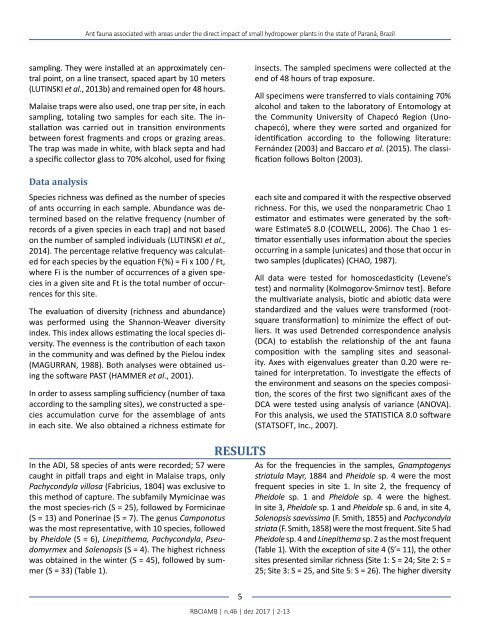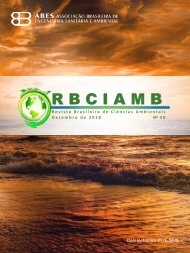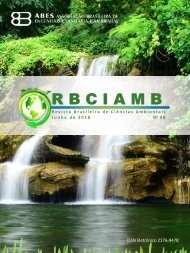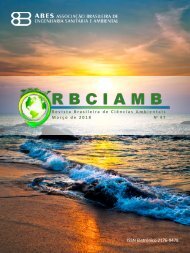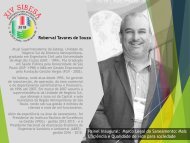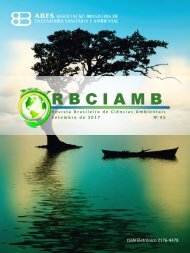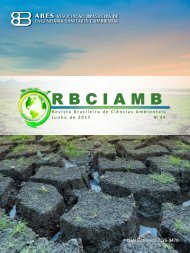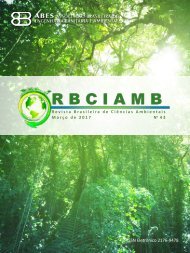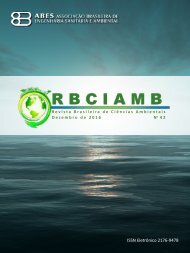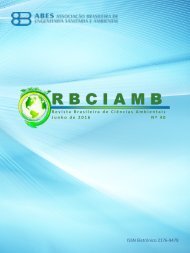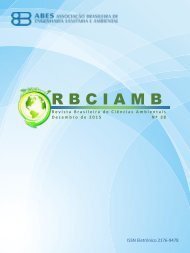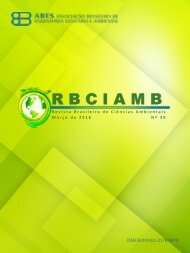Edição 46 RBCIAMB
Create successful ePaper yourself
Turn your PDF publications into a flip-book with our unique Google optimized e-Paper software.
Ant fauna associated with areas under the direct impact of small hydropower plants in the state of Paraná, Brazil<br />
sampling. They were installed at an approximately central<br />
point, on a line transect, spaced apart by 10 meters<br />
(LUTINSKI et al., 2013b) and remained open for 48 hours.<br />
Malaise traps were also used, one trap per site, in each<br />
sampling, totaling two samples for each site. The installation<br />
was carried out in transition environments<br />
between forest fragments and crops or grazing areas.<br />
The trap was made in white, with black septa and had<br />
a specific collector glass to 70% alcohol, used for fixing<br />
Data analysis<br />
Species richness was defined as the number of species<br />
of ants occurring in each sample. Abundance was determined<br />
based on the relative frequency (number of<br />
records of a given species in each trap) and not based<br />
on the number of sampled individuals (LUTINSKI et al.,<br />
2014). The percentage relative frequency was calculated<br />
for each species by the equation F(%) = Fi x 100 / Ft,<br />
where Fi is the number of occurrences of a given species<br />
in a given site and Ft is the total number of occurrences<br />
for this site.<br />
The evaluation of diversity (richness and abundance)<br />
was performed using the Shannon-Weaver diversity<br />
index. This index allows estimating the local species diversity.<br />
The evenness is the contribution of each taxon<br />
in the community and was defined by the Pielou index<br />
(MAGURRAN, 1988). Both analyses were obtained using<br />
the software PAST (HAMMER et al., 2001).<br />
In order to assess sampling sufficiency (number of taxa<br />
according to the sampling sites), we constructed a species<br />
accumulation curve for the assemblage of ants<br />
in each site. We also obtained a richness estimate for<br />
insects. The sampled specimens were collected at the<br />
end of 48 hours of trap exposure.<br />
All specimens were transferred to vials containing 70%<br />
alcohol and taken to the laboratory of Entomology at<br />
the Community University of Chapecó Region (Unochapecó),<br />
where they were sorted and organized for<br />
identification according to the following literature:<br />
Fernández (2003) and Baccaro et al. (2015). The classification<br />
follows Bolton (2003).<br />
each site and compared it with the respective observed<br />
richness. For this, we used the nonparametric Chao 1<br />
estimator and estimates were generated by the software<br />
EstimateS 8.0 (COLWELL, 2006). The Chao 1 estimator<br />
essentially uses information about the species<br />
occurring in a sample (unicates) and those that occur in<br />
two samples (duplicates) (CHAO, 1987).<br />
All data were tested for homoscedasticity (Levene’s<br />
test) and normality (Kolmogorov-Smirnov test). Before<br />
the multivariate analysis, biotic and abiotic data were<br />
standardized and the values were transformed (rootsquare<br />
transformation) to minimize the effect of outliers.<br />
It was used Detrended correspondence analysis<br />
(DCA) to establish the relationship of the ant fauna<br />
composition with the sampling sites and seasonality.<br />
Axes with eigenvalues greater than 0.20 were retained<br />
for interpretation. To investigate the effects of<br />
the environment and seasons on the species composition,<br />
the scores of the first two significant axes of the<br />
DCA were tested using analysis of variance (ANOVA).<br />
For this analysis, we used the STATISTICA 8.0 software<br />
(STATSOFT, Inc., 2007).<br />
In the ADI, 58 species of ants were recorded; 57 were<br />
caught in pitfall traps and eight in Malaise traps, only<br />
Pachycondyla villosa (Fabricius, 1804) was exclusive to<br />
this method of capture. The subfamily Mymicinae was<br />
the most species-rich (S = 25), followed by Formicinae<br />
(S = 13) and Ponerinae (S = 7). The genus Camponotus<br />
was the most representative, with 10 species, followed<br />
by Pheidole (S = 6), Linepithema, Pachycondyla, Pseudomyrmex<br />
and Solenopsis (S = 4). The highest richness<br />
was obtained in the winter (S = 45), followed by summer<br />
(S = 33) (Table 1).<br />
RESULTS<br />
As for the frequencies in the samples, Gnamptogenys<br />
striatula Mayr, 1884 and Pheidole sp. 4 were the most<br />
frequent species in site 1. In site 2, the frequency of<br />
Pheidole sp. 1 and Pheidole sp. 4 were the highest.<br />
In site 3, Pheidole sp. 1 and Pheidole sp. 6 and, in site 4,<br />
Solenopsis saevissima (F. Smith, 1855) and Pachycondyla<br />
striata (F. Smith, 1858) were the most frequent. Site 5 had<br />
Pheidole sp. 4 and Linepithema sp. 2 as the most frequent<br />
(Table 1). With the exception of site 4 (S’= 11), the other<br />
sites presented similar richness (Site 1: S = 24; Site 2: S =<br />
25; Site 3: S = 25, and Site 5: S = 26). The higher diversity<br />
5<br />
<strong>RBCIAMB</strong> | n.<strong>46</strong> | dez 2017 | 2-13


